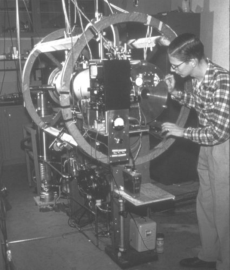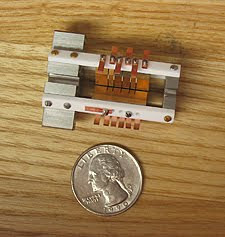| All postings by author | previous: summary | up: contents of relativity | next: advantage of teaching Lorentz's view |
|
General relativity 
An extension that Einstein added to his relativity theory explained above, adds in the effects of acceleration and gravity. He called this extension "general relativity", in contrast to "special relativity" that he used to refer to his physics of high speed motion. Concerning gravity, he guessed that in a laboratory inside a space ship coasting along in the presence of the gravitational field of a planet, that everything would appear the same as it would without the gravitational field. Only when the space men or women looked outside their ship could they tell that their path was being altered by the gravitational pull of the planet. Einstein created a math of space and time that would account for gravitational fields in a similar fashion as the above "special" relativity, by allowing massive bodies, such as a planet or star, to warp space and time. The gravitationally curved coasting trajectory of a spaceship would be a "straight line" in Einstein's warped space. This theory does give results consistent with Newton's gravitational theory and also predicts effects that Newton's theory did not, such as a slowing of time in an intense gravitational field. This slowing has been experimentally verified by the Pound-Rebka experiment done in 1959 as well as by other experiments in space craft. General relativity does not suffer all the paradoxes of special relativity. In general relativity we can assign unique properties to each point in space which depend on the energy-momentum density at that point. It is also easy to argue that the reference frame of space located far away from massive bodies forms an absolute reference frame. A valid criticism of general relativity is that it represents "physics via mathematical transforms" and thus does a poor job of the explaining at an intuitive level the causes of observed gravitational effects. Also, it generally is very laborious to use. Perhaps an ether theory of gravity would be a nice supplement to Einstein's theory. |
What is space?
The debate between Einstein and Lorentz questions what space is at a fundamental level.
Einstein's view and that of most modern physicists is that it is an empty void without many properties, and in which elemental point-like particles move around. These particles include electrons, protons, neutrons, and photons, and many many other types of sub-atomic particles moving about and interacting via the rules of quantum mechanics. A soup of these particles brings with it a momentum and energy density which effects the curvature of space-time as prescribed in the Einstein field equation. This curvature of space is a property that Einstein's space supports, as well as the property that elemental particles can exist in it. In this view, electric and magnetic fields consists of exchanges of photons between other elemental particles. Efforts by physicists to change the view of gravity from Einstein's distortion of the metric into an exchanges of hypothetical particles called gravitons have so far failed.
Lorentz's view is that space is full of an ether and electric and magnetic fields are stresses in this ether. He would probably also subscribe to gravity being a different sort of stress of the same ether.
At a deep level we will never know what "reality" is. We really only know what our humanly senses tell us: what we actually see with our own eyes and feel with our own hands, etc. Scientific theories are tremendous abstractions from the sensations of our daily lives. We make these scientific theories of the world to explain events we detect via complex instruments but eventually see the results with our eyes. The theories help us invent technologies that help us on a very human level, such as saving a loved one from dying or allowing us to talk to a friend at home while riding on a train.
It is very possible that two different views of reality are equally valid given the scientific evidence we have, if they both result in a faithful reproduction of the world as we humans experience it. Even if one is slightly off in some domain it still may be very useful; for example, the use of Newtonian mechanics for all ordinary engineering design work where velocities are much much slower than the speed of light.
Is ether dead?
Today most modern physicists, as a group, subscribe to Einstein's view of high speed physics which does not include the use of ether. The reason is heavily historical. In the race to finish a complete theory of high speed motion around 1900, Einstein won. His theory was simple, elegant, and filled a void as needed. Even today, it is fairly easy to use and easy to teach. You start with the constant velocity of light and all the rest falls out. Its chief weakness is that it cuts off any inquiry into what is underneath relativity. What makes it work? To really get at what makes relativity work, we need an absolute reference frame that is at rest with respect to the ether so that we can explore the inner workings of the ether.
Most physicists are pragmatic. Without any startling discovery, there is little reason for them to take another look at the ether possibility. On the other hand, there are some physicists who wonder if an ether theory wouldn't be easier to understand and interesting to delve into. For example, John Bell, better known for his theorem on quantum mechanics, once expressed an interest in teaching relativity via the ether theory. Below is a listing of possible benefits to looking again at ether as an explanation of the odd effects of relativity. Perhaps ether would help explain the mysterious dark matter in space. Or perhaps the absolute reference frame of space and ether is tied to the center of mass of the big bang that is currently thought to have started our universe 13.7 billion years ago.

| 
| 
|
| Fig. 13a. An early atomic clock, circa 1952, developed at NIST. NIST, the National Institute of Standards and Technology is a US government laboratory which constantly strives to improve clocks and time standards. It used a microwave transition in caesium atoms to achieve this accuracy. | Fig. 13b. Caesium (formerly spelled "cesium") fountain atomic clock at NIST developed in the last decade achieves an accuracy of 5×10-16, i.e. accurate to a second in 100 million years. It uses a microwave transition in freely falling caesium atoms to achieve this accuracy. | Fig. 13c. The core of the most recent clock at NIST. This photo is of the electromagnetic trap which traps aluminum and magnesium ions. An ultraviolet transition of a single aluminum ion in this trap is used to drive the clock. This clock has achieved an accuracy of 100 times that of the caesium clock at the left ["Relativistic effects seen at everyday distances and speeds", Barbara Goss Levi, Physics Today, 63 11 (Nov.2010), pp. 16-17]. |
| A pair of clocks shown in Fig. 13c have
been used to confirm speed related time dilation as well as
gravitational time dilation. Speed related time dilation has also been
confirmed by various satellite experiments and with Mossbauer experiments.
Length contraction has not been directly confirmed, however various relativity equations that are derived from the Lorentz transforms have been repeatedly confirmed in scattering experiments involving high energy subatomic particles. Because length contraction is one of the foundations of the Lorentz transforms, this probably implies that length contraction is valid in the real world. A simple direct experiment confirming length contraction alone is certainly overdue. | ||
| All postings by author | previous: summary | up: contents of relativity | next: advantage of teaching Lorentz's view |